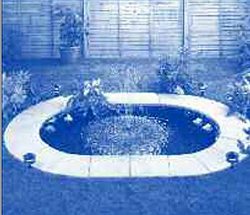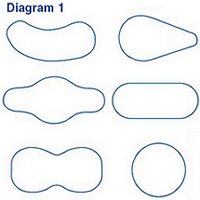Planning a Garden Pond
 Water brings a new dimension to any garden, allowing you to grow a wider range of plants and to rear some attractive fish - not to mention all the wildlife that will be drawn to your new pond. If you add a fountain or a small waterfall, you'll be able to enjoy the relaxing sounds of water splashing its way back into the pond as you sit in the garden.
Water brings a new dimension to any garden, allowing you to grow a wider range of plants and to rear some attractive fish - not to mention all the wildlife that will be drawn to your new pond. If you add a fountain or a small waterfall, you'll be able to enjoy the relaxing sounds of water splashing its way back into the pond as you sit in the garden.
A well planned pond can be the visual centre piece of your garden, especially if you create a three-dimensional effect by incorporating a rockery behind it. This would also be the perfect site for your waterfall, which can run down between the stones just like a natural spring.
It's surprisingly easy to create a pond in even the smallest garden, thanks to the development of long-life flexible liners. All you have to do is dig a hole in the ground, lay the liner in place over an underlay and fill it with water, ready to receive plants and fish. Add a small submersible pump, a length of hose and a second section of liner and you can easily create a fountain and waterfall too.
The Wickes pond liners are made from black PVC, which gives a greater impression of depth than other colours and is more resistant to degradation by ultra-violet light.
Decide on the pond location
Try to choose a position where you can admire the pond from your favourite sitting-out position. The ideal pond site is in a sunny spot, sheltered from cold northerly winds and well away from trees that shed their leaves. Too much shade will encourage algal growth, while falling leaves will soon clog up the pond in autumn. In fact, it's best to avoid sites near any large trees, since their roots could spread and damage the liner in the future.
There's no reason why you should not build your pond on a sloping site, so long as you are prepared either to cut into the slope or to build a retaining wall or bank on the downhill side of the pond. Such a site can also be a natural one for a waterfall. The only thing that might cause trouble is if you live in a very marshy area, or one with a high water table (the level of natural underground water). In either of these cases, the pond liner may tend to float upwards due to pressure of water from below. You can check this by digging a small hole to the required depth of your pond and noting whether water accumulates or not - if it does to any noticeable extent the site is not suitable for a pond.
Decide on the type
You can create a pond either by sinking a preformed rigid plastic or glass fibre shell in the ground, or by lining the excavation with a flexible liner. The latter is the more popular choice for several reasons: it's easier to transport since it comes folded in a box; it's easier to install, it also allows you complete freedom of choice as far as the pond shape and depth are concerned, and this is the type that Wickes sell. The thickness of the liner ensures long life so long as it is properly installed, it can be repaired easily with patches if it is punctured accidentally. Also, the fact that it follows the contours of the ground results in a much more natural-looking pond.
You can also use flexible liners for above ground formal ponds with raised brick or stone walls too.
Decide on the pond shape and size
 The Wickes pond liners can be used to create a formal or informal shape. The formal will be a square, rectangle or circle, while the informal can be any shape you like within reason; it's best to avoid curves and inlets that are too "sharp". Diagram 1 shows a few possible layouts.
The Wickes pond liners can be used to create a formal or informal shape. The formal will be a square, rectangle or circle, while the informal can be any shape you like within reason; it's best to avoid curves and inlets that are too "sharp". Diagram 1 shows a few possible layouts.
A pond needs a minimum surface area of about 3m² (32sq.ft) for it to become self supporting as far as plant and aquatic life is concerned; smaller ponds may not contain enough oxygen and so tend to stagnate.
A pond should ideally have at least two depths, a marginal shelf (about 230mm (9")) on which pond plans can be sat, and a deeper area (about 450 to 600mm (18 to 24")), where fish can dive to should the pond freeze over in winter.
The simplest way of establishing the shape and size you want is to lay garden hose or rope out on the pond site, and to view it from various positions. It's often helpful to look at it from an upstairs window as well as from ground level. Keep a check on the size since it is easy to plan.
Think about extra features
Decide at the planning stage whether you want to incorporate extra features such as a waterfall, a fountain, garden lighting, and the like in your pond construction. Apart from the relaxing sound moving water creates, the movement helps to aerate the water too. A fountain brings a three-dimensional effect to your pond, and can look sensational at night coupled with outdoor lights around the pond.
Most ponds will attract a variety of animals found in the garden. Therefore think about providing for them too. If you have Hedgehogs in your garden, think about providing a sloping beach for them to climb up if they fall in, or use plants to help them escape.
Plan a power supply
If you're using a pump to circulate water to a fountain or waterfall, and perhaps using outdoor lights, you'll need a power supply to the vicinity of the pond. This must be a permanent supply run underground from the house using toughened cable, not a trailing flex plugged into a socket outlet. For complete safety, the circuit to the pond should be protected by a 30mA residual current device (RCD). - see CUSTOMER CARE and also step 12 in our installation page.
All electrical work must conform to BS 7671 the current IEE Wiring Regulations, and Part P of Building Regulations. You are advised to check with your local authority's Building Control Department, or an Authorised Competent Person, before starting. If in any doubt about electrical work, contact a qualified electrician.
Safety around a pond
There are two major points to remember as far as safety is concerned: electrics and children.
Electricity used out of doors can be dangerous, so if you need a power supply for a pump or outdoor lights, ensure that it is provided by a permanent circuit run from a spare fuseway in your consumer unit (or from an additional consumer unit mounted alongside if you have no spare fuseway).
You are not permitted to run a spur from an existing house power circuit. The new circuit should be run in special toughened outdoor cable, buried in a trench at least 500mm deep running from the house to the pond. At the pond end the cable is linked to the pump flex inside a special weatherproof junction box. At the house end it should be wired to a piece of safety equipment called a residual current device (RCD), which will cut off the supply to the circuit in the event of an electrical fault. If you are in any doubt about your ability to carry out electrical work, call in a qualified electrician to do the job for you. You will also need professional help if a new consumer unit is required.
If you have small children in the family, the main risk is of them falling into the pond. You can guard against this in several ways. One is to erect a low fence around the pond, or to build a raised pond rather than a ground-level one. The alternative is to create just a water feature that has no deep water - perhaps as a waterfall linking a small header pond at the top to a fountain that discharges into a shallow basin filled with pebbles at the bottom. With this arrangement however, you won't be able to keep fish.
see our other page for building a garden pond using a liner
Whilst every care has been taken to ensure that the product design, descriptions, specifications and techniques of construction are accurate at the date of printing. Wickes products will inevitably change from time to time and the customer is advised to check that the design, descriptions, specifications and techniques of constructing any of the products described in this leaflet are still valid at the time of purchase or placing an order. © Wickes Building Supplies Limited 2000. All rights reserved. www.gardeningdata.co.uk/ has Wickes permission to reproduce this article.
All rights reserved. No part of this publication may be produced or transmitted in any form or by any means electronic, mechanical, photocopying, recording or otherwise or stored in any retrieval system of any nature without the written permission of the copyright holder and the publisher.

